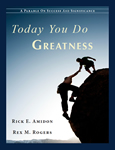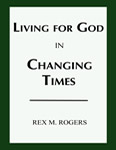- Details
- Written by Rex M. Rogers
Big Blue celebrates its one hundredth anniversary this week, quite an accomplishment for any business, even more so one in technology. IBM’s four full pages in “The Wall Street Journal” acknowledged where the company made mistakes, what it learned, and how it tried to create a culture oriented to the long-term.
Out of 25 top United States corporations in 1900, only 2 continued in operation in 1960. Of the top 25 companies in 1961, only 6 still exist today. So IBM’s 100 years is indeed impressive.
What did IBM learn? “Not to confuse charisma with leadership,” “Leadership often requires shedding emotional attachment to (its) heritage,” and “Leaders must show up in defense of the future.” Notice all these points are about leadership. IBM learned and demonstrated that leadership that grows, that looks proactively forward, that acts with integrity reinforces a company’s potential for surviving and thriving.
Leadership is not the end of an organization, but it is most certainly one of the key and essential means to determining the end of the organization. Leaders must be future-oriented or by definition function behind the curve. On behalf of their organizations leaders must stir and stimulate their organizations even to the point of discomfort—that is, if they and others within truly want the organization to improve by competing with itself.
Thomas Watson, Sr and Thomas Watson, Jr set IBM on a path to greatness that faltered. Louis V. Gerstner, Jr rescued and resuscitated IBM, putting it back on track. Gerstner wrote about IBM’s radical self-induced culture change in one of the best leadership books I’ve ever read, Who Said Elephants Can’t Dance? Inside IBM’s Historic Turnaround.
Leadership involves more courage than most people think. It’s easy to slide, to duck, to wink at percolating problems. It takes courage to tackle them head on. IBM has been blessed with more such leaders than most organizations can claim. Consequently, it’s celebrating its one hundredth birthday.
© Rex M. Rogers – All Rights Reserved, 2011
*This blog may be reproduced in whole or in part with a full attribution statement. Contact Rex or read more commentary on current issues and events at www.rexmrogers.com or follow him at www.twitter.com/RexMRogers.
- Details
- Written by Rex M. Rogers
“McEnroe/Borg: Fire and Ice” is one of HBO’s “Legends and Legacies” summer documentaries. I watched it earlier this week and recommend it highly. It’s 60 minutes of interviews and matches worth watching; indeed, if you like tennis, it’s downright enjoyable.
Bjorn Borg is the stoic Swede who took the tennis world by storm as a teenager with Viking good looks and an even more stunning game. He won six Wimbledon tennis championships in a row and dominated tennis during ten years of sensational baseline tennis in the 1970s and early 1980s.
John McEnroe is the volatile New Yorker who took the tennis world by storm as a teenager with long frizzy hair and a frenetic energy that burst from both his racket and his mouth. He eventually ended Borg’s Wimbledon run and beat him in the U.S. Open final in exceptional serve and volley, yell-at-the-umpire (“You can’t be serious), incredible tennis.
Nothing surpasses Borg and McEnroe’s 1980 Wimbledon final on Centre Court at the All England Club. McEnroe saved 7 match points and finally won the 4th set tie-breaker 18-16 in what is yet today considered one of the game’s most riveting, indeed one of sport’s most spellbinding, events. Borg came back to win the decisive 5th set 8-6, and with that, the championship. They went on to split other matches, but Borg soon retired and McEnroe followed not long thereafter. Neither man won a major championship after the age of 25. Like Ali and Frazier, McEnroe and Borg needed one another.
Borg and McEnroe’s rivalry is compelling in part of course because of the highest level of tennis excellence they consistently drew out of each other, but also because of their friendship. As they both said in the documentary, they liked and respected each other from the beginning. Now they use the term “love.”
I watched nearly all their matches over five years including every point of the 1980 Wimbledon final. There’s not been another rivalry like them. Roger Federer and Rafael Nadal have produced some great matches, including especially the 2008 Wimbledon final. But they do not have the personalities of McEnroe and Borg and they have not made the same kind of impact upon the game, much less beyond it.
Watching “Fire and Ice” brought back a lot of memories. I was 28 in 1980, not too much older than the players. McEnroe and Borg’s antics, excellence, and accomplishments, their contrasting styles and personalities, their resolve and friendship were and are inspiring. Their head-to-head rivalry ranks with Palmer and Nicklaus. The fact they’ve survived various life and business foibles with their friendship flourishing represents what sports at their best are about.
© Rex M. Rogers – All Rights Reserved, 2011
*This blog may be reproduced in whole or in part with a full attribution statement. Contact Rex or read more commentary on current issues and events at www.rexmrogers.com or follow him at www.twitter.com/RexMRogers.
- Details
- Written by Rex M. Rogers
I recently watched HBO’s new documentary “Bobby Fischer Against The World.” It’s an interesting but sad review of the anguished genius’s life.
Bobby Fischer (1943-2008) was clearly a prodigy, perhaps the greatest chess master in history, one who shot to worldwide fame at just 14 years of age when he became the youngest US champion in history. He played in 8 US Chess Championships in a row, winning them all. At 16 he published his first book becoming the youngest author in chess history.
At age 29 in 1972 in Reykjavik, Iceland, Fischer reached his peak by playing Russia’s Boris Spassky for the World Chess Championship. It was the Cold War: Russia versus the United States without fighting. The entire world watched a series of chess matches that Fischer came from behind to win spectacularly, sealing his fame forever.
If Fischer’s life had ended there it might have been to his good, but he lived to age 64, along the way by turns becoming a religious fanatic, conspiracy theorist, anti-American fugitive, and an anti-Semite. The last one was the most odd because Fischer was Jewish. After 9/11 he said the chickens had come home to roost for America and he later wrote a letter to Osama bin Laden claiming they had a lot in common against America.
Fischer was a prodigy. He was anguished lonely loner, and eventually, he evidenced clear and repetitive signs of paranoia and mental illness. He was a tragic genius in every sense of the phrase.
In the summer of 1972 I was in college between my sophomore and junior year. Watching the documentary, sobering though it was, brought back a lot of memories: the weird clothes and long hair, the cars, the sideburns, the news anchors and public personalities. I remember following Fischer and Spassky too.
I played chess through high school and much of college. In high school Physics class several of us played every day. During my undergrad years I came in second in the college tournament two years in a row, beaten both years by my roommate Timothy Barker. We enjoyed the mental challenge of the game, liked the strategy, and followed the Fischer saga for part chess, part patriotic reasons.
Fischer’s story is one of what might have been. What might he have become if he’d not lost his father at a young age and his mother hadn’t abandoned him when he was a teenager? What chess majesty might have been his had he been able to overcome his volatility and emotional pain to play competitively for the next fifteen years after winning the World Championship? What even greater greatness might he have enjoyed had he been able to function as a sociable champion? What would have been his larger impact upon the game of chess if he’d been able to teach, play more, or become an ambassador for the game? Unfortunately we’ll never know.
Just three years ago Fischer died of renal failure in Iceland, refusing treatment and reputedly uttering as his last words, “Nothing is as healing as the human touch.” His life is an American tragedy with a high watermark in the early 1970s.
© Rex M. Rogers – All Rights Reserved, 2011
*This blog may be reproduced in whole or in part with a full attribution statement. Contact Rex or read more commentary on current issues and events at www.rexmrogers.com or follow him at www.twitter.com/RexMRogers.
- Details
- Written by Dan
- Details
- Written by Rex M. Rogers
Michigan has lifted its ban on deer baiting. Too bad. This relatively new hunting habit should be banned for good in Michigan and in every other state. Currently, 28 states ban deer baiting, 8 others limit the practice.
Baiting is the practice of placing carrots or sugar beets or some other food product in piles in the woods to attract deer (or bear) to the food source. Hunters set up nearby and wait for deer, conditioned after a few days of finding food in this spot, walk into range of hunters’ firepower.
Deer baiting seems to me to remove much of the challenge or sport of hunting deer. Unsuspecting deer become ducks in a barrel. The hunter doesn’t have to take time learning deer’s habits, tracking them, or finding the place to stand that most probably will offer a shot opportunity later in the day. Apparently my view is shared by some who support baiting because one of their arguments is that they “don’t have time” to do “real hunting.” No, with baiting, hunters simply bait-and-wait. Doesn’t seem like much of a sport to me.
Banning deer baiting helps reduce the possibility of the spread of disease like bovine TB or chronic wasting disease, which is why Michigan banned the practice for the past few years. Baiting increases likelihood of disease because animals are eating in one place rather than multiple places across the landscape. Now, though, because of political pressure, baiting is back.
Deer baiting is generally not supported by natural resource scientists or their scientific studies. It’s not supported by environmentalists or conservationists. It’s not even supported by most hunters, just a minority who apparently believe they cannot hunt deer in any other way.
I’m not against hunting. Actually, I think baiting harms hunting because it removes much of the need for hunters to spend time in the craft and improve their hunting skills. To put it bluntly, about anyone can sit with a gun and shoot when a target comes in view. That’s not hunting. It’s a carnival shooting gallery.
Baiting should be banned for hunting of any and all animals in all states. Banning baiting for good would be better for not just the animals, or for the sensibilities of the modern public, but for hunters and hunting too. What’s not to like about that?
© Rex M. Rogers – All Rights Reserved, 2011
*This blog may be reproduced in whole or in part with a full attribution statement. Contact Rex or read more commentary on current issues and events at www.rexmrogers.com or follow him at www.twitter.com/RexMRogers.
- Details
- Written by Rex M. Rogers
Sports pundits are now writing the requiem of Tiger Woods’s career in professional golf. They’re saying he’ll never win 5 more major championships to surpass Jack Nicklaus. Some, astoundingly, are saying Tiger may not win 5 more tournaments. But come on, the man’s only 35 years old.
I’ve written about Tiger’s character issues. And I’ve written about what he needs to do to reboot his life. Clearly, right now he’s experiencing knee injury problems and his public interviews seem to indicate he’s still struggling with anger and perhaps other emotional issues. Who wouldn’t, given what he’s put himself through and given the family and reputational price he’s paid?
But the man’s only 35 years old, he still must be considered the most gifted golfer in the world, and he has time. Tiger has won 14 major championships. Jack Nicklaus won his last of 18 majors, the high watermark of professional golf, when he was 46 years old. So on that measure alone Tiger has 11 more years.
In eleven years, representing 4 majors per year, it seems to me Tiger might reasonably be expected to win 5 out of 44 major championships. But to give sports pundits their due, this assumes several things that all must come together, and no one, not even Tiger, knows for sure that they will, i.e. his return to physical and mental or spiritual well-being.
But I’m not ready to give up on Tiger. I think he’s surly and often un-likeable. But I don’t wish him ill, I believe his personality could make a George Foreman change if Tiger took certain spiritual steps, I still believe his phenomenal golf skills are there to be reawakened, and I think he has time. So we’ll see.
As just another human being with issues like the rest of us, here’s hoping Tiger gets the help he needs--maybe from "Big George" Foreman himself.
© Rex M. Rogers – All Rights Reserved, 2011
*This blog may be reproduced in whole or in part with a full attribution statement. Contact Rex or read more commentary on current issues and events at www.rexmrogers.com or follow him at www.twitter.com/RexMRogers.


